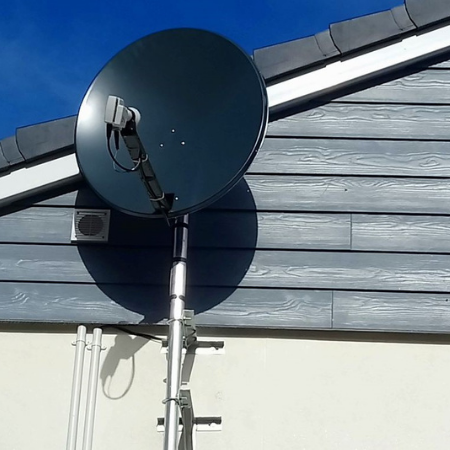Whether it’s a Sky dish or another style, make, or brand, satellite dishes have become a familiar sight around the country. Because they’ve enhanced – and increased – our viewing habits, they’re an essential piece of kit for almost every homeowner, but how long does a satellite dish last?
What can affect dish performance?
As with most items or products, how long anything lasts comes down to plenty of variables, so there’s never a single, right answer. But on average, you should be able to get around 10-15 years trouble-free use out of your satellite dish. The quality of your dish, the material it’s made of, its location – and that of your home – and how well (or badly) it’s installed are all factors that can affect both its performance and longevity.
Satellite dish – quality
A good quality product will always last longer than one of poorer, cheaper quality, and that goes for satellite dishes too. If you’re buying a dish, then don’t aim for the cheapest or a budget model thinking it will be the best. We always recommend tried and trusted brands such as Triax, Vision, or Inverto for superior quality and service.
Satellite dish – material
Dishes can be made from several different materials, all of which have pros and cons attached to them. The most common material is steel – a relatively low-cost material providing the strength and stability needed for most installations. But problems can occur when they’re painted as the paint will flake or peel over time, leading to rust.
Aluminium dishes are a good alternative, giving you more years of service without degradation or rusting. However, these can be more expensive so the price increase should be factored in if you’re sticking to a budget. But the material we recommend is fibreglass – a long-lasting, lightweight material that won’t rust or degrade – perfect for long-term satellite dish installation. Again, it can be more expensive, but you’ll certainly get your money’s worth, and it’s available in Off-White or Charcoal Grey so it blends in with your home.
Satellite dish – location
Steel dishes can withstand a certain amount of wind and rain, but they much prefer a sheltered location, tucked away from the direct elements. As well as adverse weather affecting their alignment – though that can be true of any dish – excessive weather can shorten its life, so an alternative dish of different material might be necessary.
Where your home is also makes a difference. Even if your dish is relatively well protected from the weather, if you live near the beach, the sea air can cause dish erosion and rust. From a 10-15 year lifespan, living in a coastal location could only give you around 7 or 8 years of dish life, and a seafront home could give you less than 5 years. Another reason why we always recommend a fibreglass dish.
Satellite dish – installation
Whatever style, make, or brand of your dish, if it hasn’t been installed professionally, you risk alignment problems, dish damage, and bad signal – as well as potentially shortening its lifespan. It’s always best to leave any satellite dish installation to the experts and that’s where Plymouth Aerial Solutions can help you.
We have the experience and all the right credentials to help you with your dish installation, including working at height to safely install it in the optimum position and get it right first time – all to give you a satellite dish that lasts.
Let Plymouth Aerial Solutions help you
Together with expert satellite dish installations, we can help you with every part of your satellite journey. We have plenty of product knowledge to help you choose the right dish for you and your home as well as your overall set-up, and we can source the right products and equipment for you too.
So when your dish is in need of replacement or repair, call us today on 01752 296 781 or get in touch to leave us a message and ask us anything. We’re here to help you.

